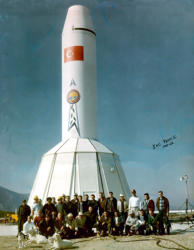
Jupiter SM-78 Weapon System
I&C Team 2, Çigli AB, Turkey 1961-1962 Chrysler Corporation Missile DivisionHISTORY - Page 26
In other words, the opportunity for research was small, and ABMA felt that NAA's engine was only marginal
for the JUPITER program
34
. Be that as it may, this was the situation ABMA faced in 1956.
In getting the Army-Navy program under way, operational priority goals were established. The first was to
comply with the DOD directive to design a basic missile that was responsive to land and sea requirements.
A second represented the desires of DOD and the State Department, and that was the demonstration of
the capability to fire a ballistic missile to a range greater than 1,000 nautical miles. From first appearances,
it seemed that parallel development was the obvious course to follow, but the Army and Navy soon
realized that there were not enough technically qualified personnel available to pursue this dual program.
In fact, they aligned their program to the basic design, an early operational capability, and, then, the long-
range shot. As a note of interest, on 20 September 1956, a JUPITER C attained an altitude of 682 St miles
and a range of 3,335 St miles, shattering all existing records at that time in both categories. This flight
admirably satisfied DOD and State Department requirements
35
.
One of the first orders of business, after the February 1958 activation, was to update the development.
Several substantial changes were made. For example, in November 1955 it had been planned to start with
a 65-foot missile and, then, gradually reduce the length, but the Navy requested that the missile be as
short as possible. So the previous plan was abandoned, and the development program was to aim for a 55-
foot missile with a 105-inch diameter (10 inches greater than had been planned). At the outset the Army
______________________________
34. Present, undated, subj: Need for a Fair Competitive Position Bet IRBM #1 & IRBM #2. Hist Off files; Ltr, WDD to ABMA, undated, subject: North American Engines for Dellivery During CY 1957, in ABMA Ref Book, subj: JUP, Part I, Tab D.
35. JUP Dev Plan, FY 1958, 29 Sep 56.35. JUP Dev Plan, FY 1958, 29 Sep 56.









HISTORY - Page 26
In other words, the opportunity for research was
small, and ABMA felt that NAA's engine was only
marginal for the JUPITER program
34
. Be that as it may,
this was the situation ABMA faced in 1956.
In getting the Army-Navy program under way,
operational priority goals were established. The first
was to comply with the DOD directive to design a
basic missile that was responsive to land and sea
requirements. A second represented the desires of
DOD and the State Department, and that was the
demonstration of the capability to fire a ballistic
missile to a range greater than 1,000 nautical miles.
From first appearances, it seemed that parallel
development was the obvious course to follow, but
the Army and Navy soon realized that there were not
enough technically qualified personnel available to
pursue this dual program. In fact, they aligned their
program to the basic design, an early operational
capability, and, then, the long-range shot. As a note
of interest, on 20 September 1956, a JUPITER C
attained an altitude of 682 St miles and a range of
3,335 St miles, shattering all existing records at that
time in both categories. This flight admirably satisfied
DOD and State Department requirements
35
.
One of the first orders of business, after the February
1958 activation, was to update the development.
Several substantial changes were made. For example,
in November 1955 it had been planned to start with a
65-foot missile and, then, gradually reduce the length,
but the Navy requested that the missile be as short
as possible. So the previous plan was abandoned, and
the development program was to aim for a 55-foot
missile with a 105-inch diameter (10 inches greater
than had been planned). At the outset the Army
______________________________
34. Present, undated, subj: Need for a Fair Competitive Position Bet IRBM #1 & IRBM #2. Hist Off files; Ltr, WDD to
ABMA, undated, subject: North American Engines for Dellivery During CY 1957, in ABMA Ref Book, subj: JUP, Part I,
Tab D.
35. JUP Dev Plan, FY 1958, 29 Sep 56.35. JUP Dev Plan, FY 1958, 29 Sep 56.





















